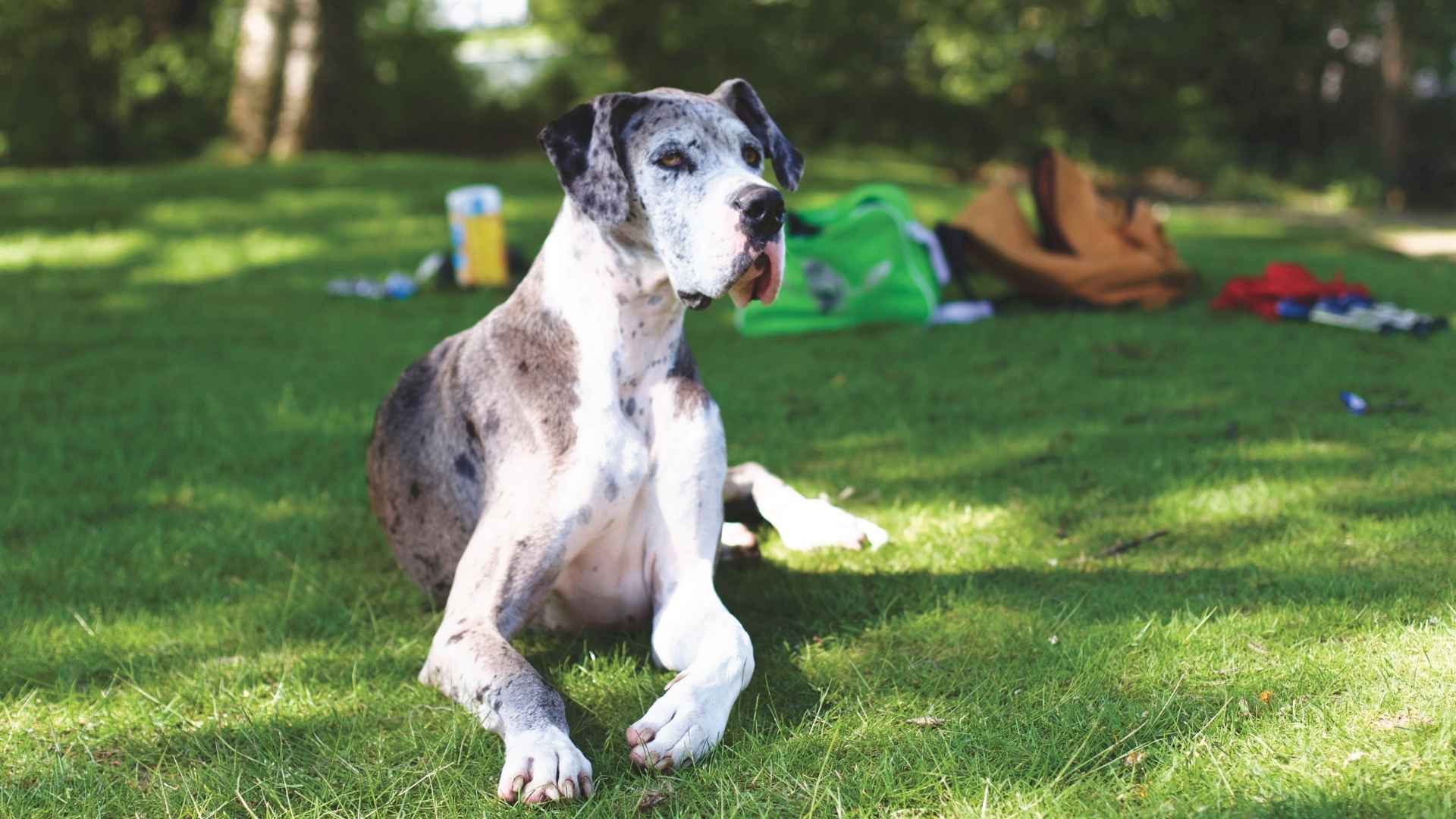Bringing a dog into your life is one of the most heartwarming decisions you can make, but what if that love story is shorter than expected? Some breeds, despite their charm, loyalty, and boundless affection, simply don’t get as much time as others.
These dogs give us everything they have in the few years they share with us, making every tail wag and cuddle that much more precious. Understanding which breeds have the shortest lifespans helps prospective owners prepare emotionally and physically to give them the best life possible.
While it’s hard to think about losing a beloved companion sooner, knowing what to expect means you can focus on what truly matters: love, comfort, and joy in every moment together. Because even a short life, when lived with love, can mean the world.
Dog Breeds With Shortest Lifespans You Should Know About Before Buying
1. Great Dane
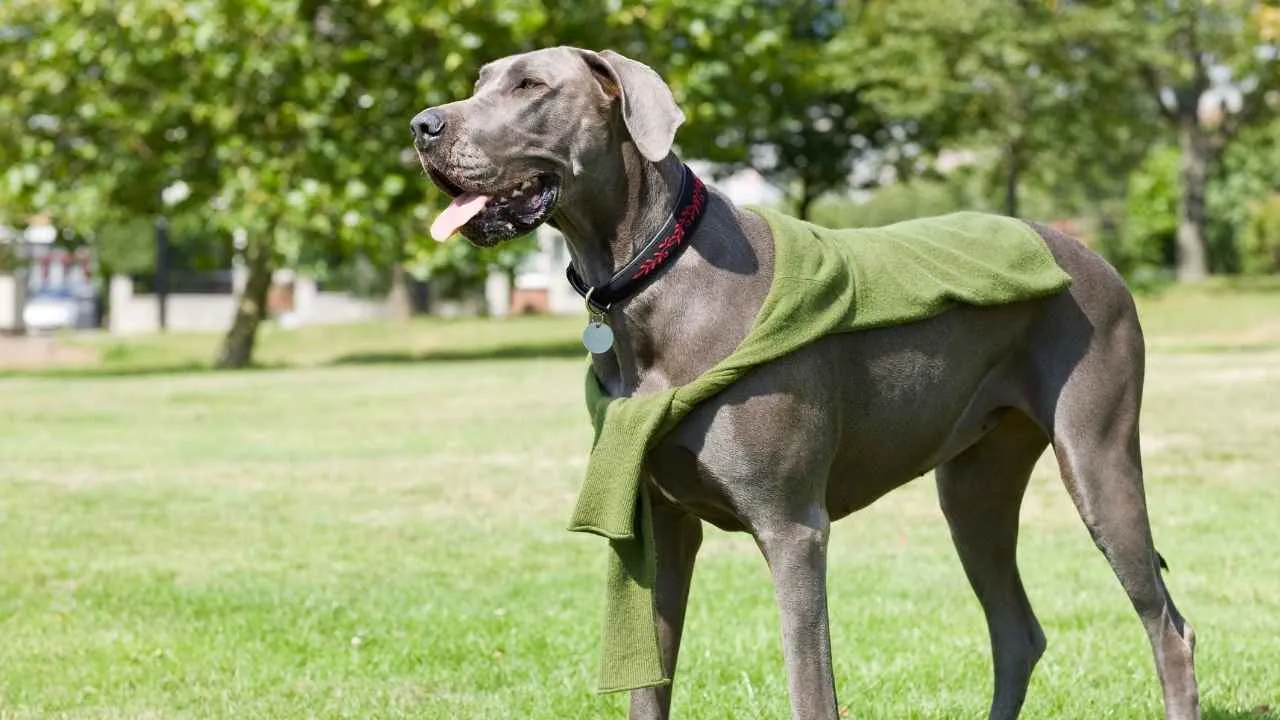
The Great Dane, often called the “Apollo of Dogs,” is admired for its majestic stature and gentle nature. Despite their towering size and regal presence, these giants have one of the shortest lifespans, typically around 7 to 10 years. Their calm demeanor and affectionate personalities make them surprisingly tender companions.
Great Danes thrive on human attention and form strong emotional bonds with their families. They’re social, affectionate, and gentle with children, though their size requires supervision around smaller kids. Their loyal and protective instincts make them both loving pets and dependable guardians.
Because of their large frames, Great Danes are prone to joint and heart conditions that affect longevity, as noted by Britannica. A balanced diet and consistent vet checkups help reduce the risks of bloat, a common issue among giant breeds. Controlled exercise supports muscle strength without overexertion.
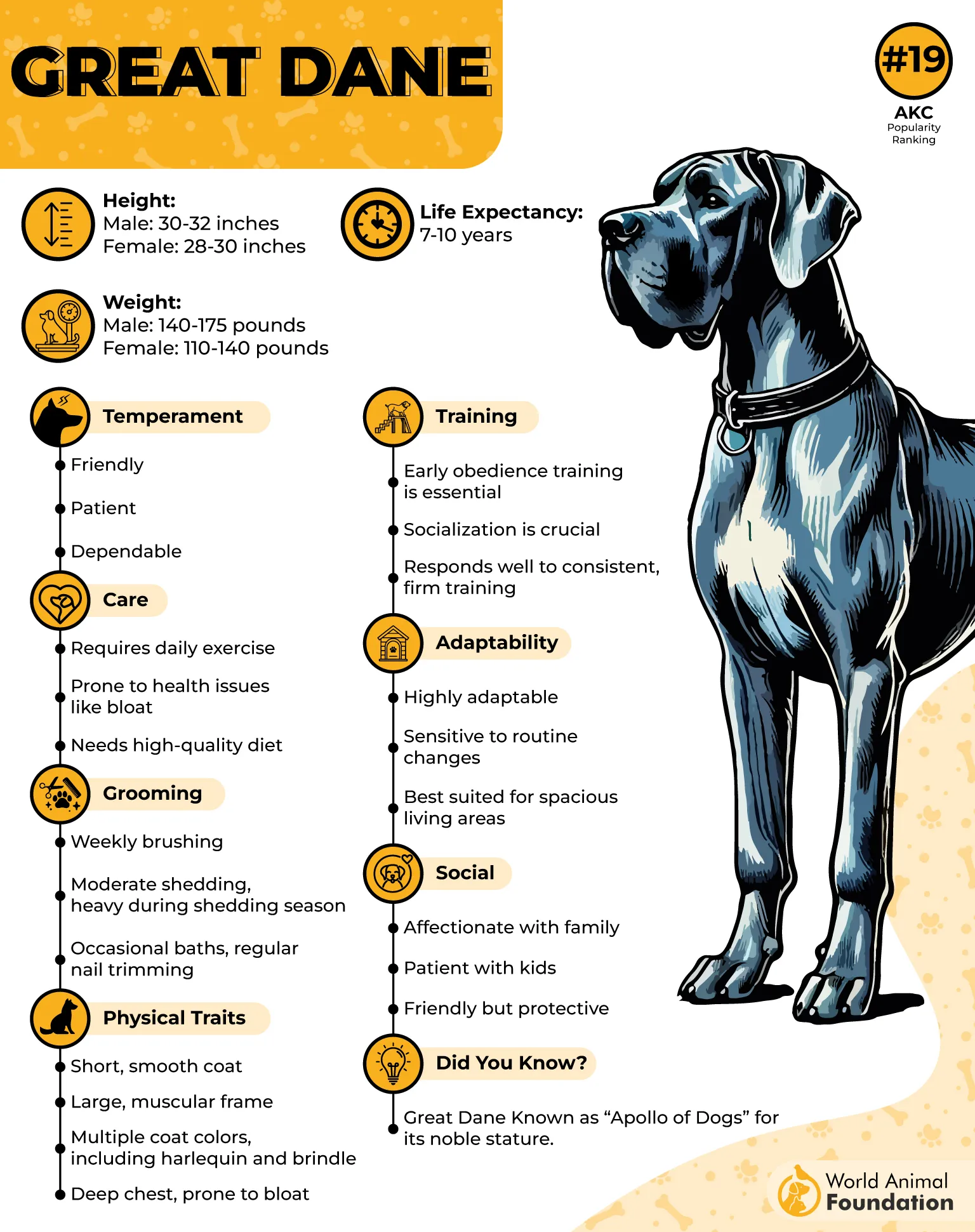
Their sleek, short coat makes grooming simple—weekly brushing keeps shedding under control. Regular nail trims and ear cleaning add to their care routine. They enjoy relaxing indoors but also appreciate moderate daily walks to maintain health.
While their time may be shorter than most, Great Danes leave a powerful emotional impact. Their kindness, intelligence, and loyalty make every year together deeply rewarding.
Quick Tips
Feed smaller, frequent meals to prevent bloat.
Offer daily light exercise to maintain joint health.
Schedule regular heart and bone health screenings.
2. Bernese Mountain Dog
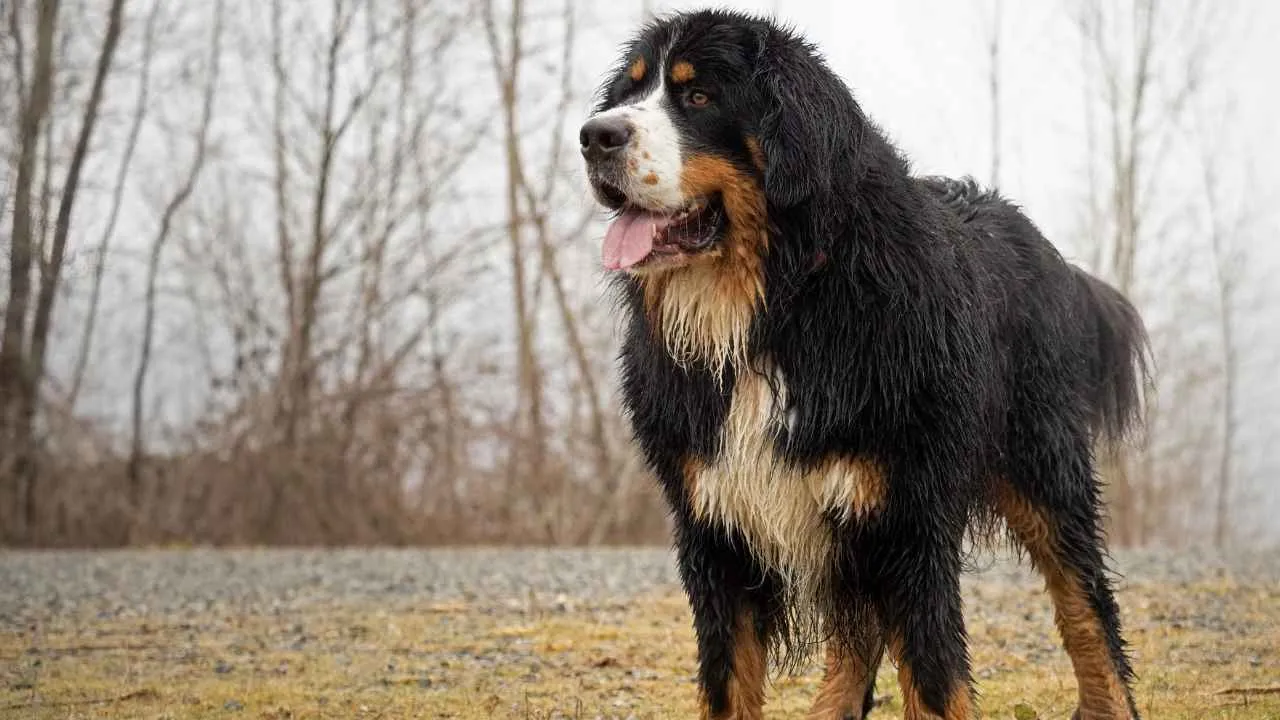
The Bernese Mountain Dog is a beloved working breed known for its loyalty, strength, and striking tri-colored coat. Despite their beauty and gentle nature, they have one of the shortest lifespans among large dog breeds—usually between 7 and 9 years. This is due to a higher incidence of health problems.
These dogs thrive in cool climates and enjoy outdoor activities with their families. They love companionship and form close emotional bonds, making them ideal for those seeking an affectionate, people-oriented pet. Their calm temperament makes them excellent around children.
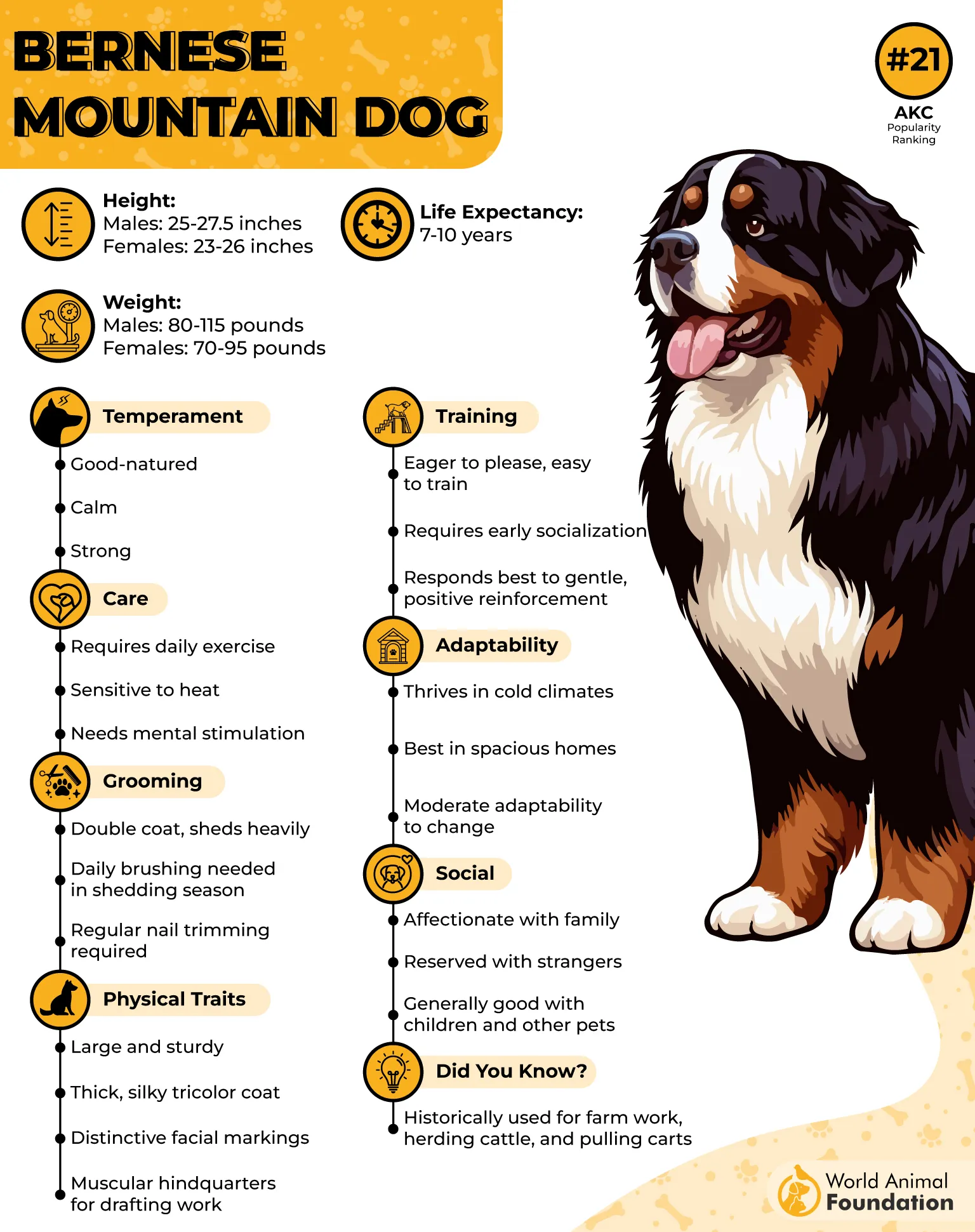
Because of their thick coats, regular grooming is a must. Weekly brushing prevents matting and manages heavy seasonal shedding. Bathing occasionally helps keep their coat shiny and healthy, especially after outdoor adventures.
As per Purina UK, health conditions like hip dysplasia and bone cancer are common concerns for this breed. Regular vet visits, weight control, and a balanced diet help manage risks. Preventive care can extend both the quality and duration of their lives.
Though their years may be few, Bernese Mountain Dogs fill every one with love and devotion. Their presence adds warmth, joy, and loyalty to any home lucky enough to have them.
Quick Tips
Brush 2–3 times a week to control shedding.
Keep them cool and well hydrated during warm months.
Schedule frequent vet checks for joint and cancer screenings.
3. Irish Wolfhound
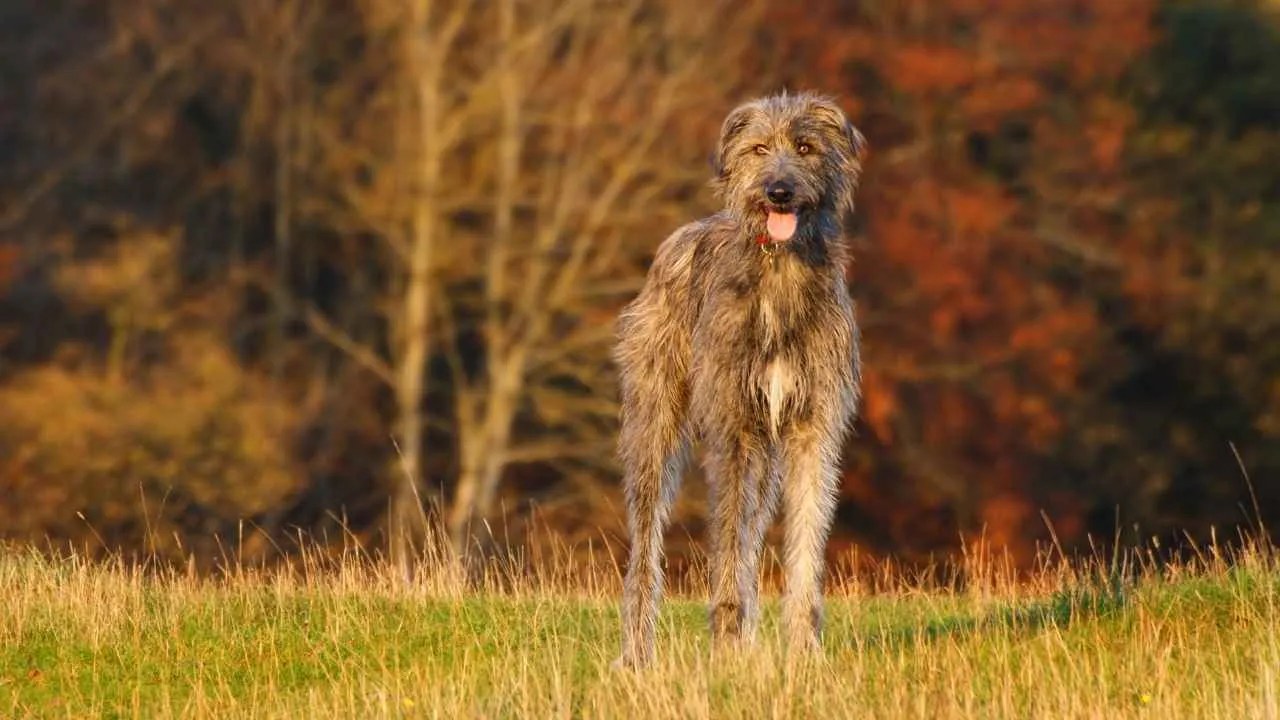
The Irish Wolfhound, one of the tallest dog breeds in the world, is admired for its quiet strength and gentle personality. Historically bred to hunt wolves and large game, this noble breed combines courage with a deeply affectionate nature. Sadly, its average lifespan is only 6 to 8 years.
Irish Wolfhounds are calm, kind, and patient, making them excellent family companions. They bond closely with their owners and often prefer peaceful environments over noisy ones. Their loyalty and gentle temperament make them wonderful pets for older children and adults.
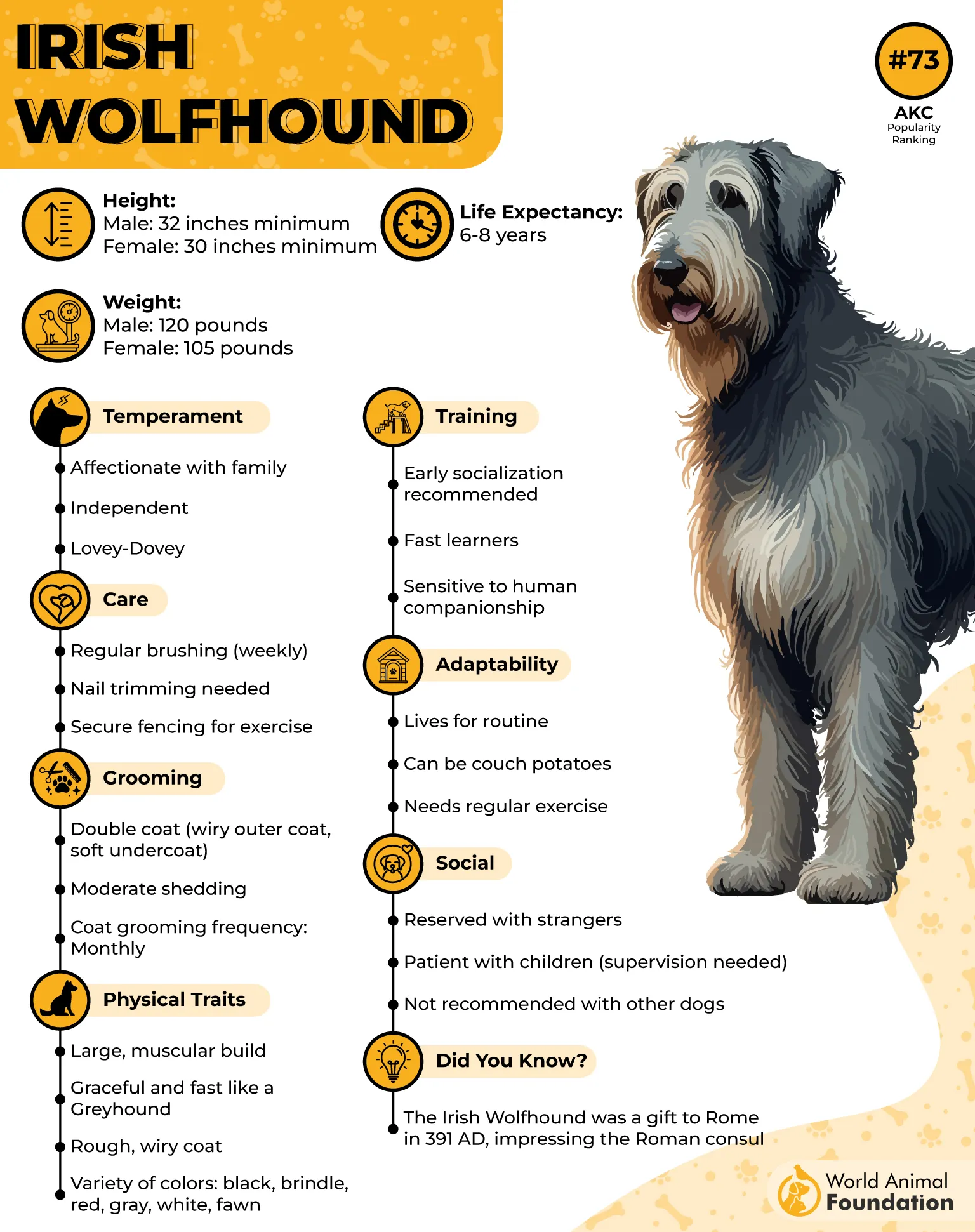
Their wiry coats are relatively easy to maintain, requiring weekly brushing and occasional baths. Regular grooming prevents tangles and keeps their coats clean after outdoor play. Due to their large size, they need ample living space and comfortable resting areas.
Health issues like heart disease, bloat, and bone disorders commonly affect this breed. Providing a proper diet, moderate exercise, and regular veterinary care can help improve both health and longevity, as suggested by WebMD. Weight management is essential to reduce joint strain.
Although their time may be brief, Irish Wolfhounds leave a lasting impression of grace and devotion. Their companionship is quiet but profound—a gentle reminder of unconditional love.
Quick Tips
Provide soft bedding to support large joints.
Offer gentle, low-impact daily walks.
Monitor heart and bone health with regular vet visits.
4. Neapolitan Mastiff
The Neapolitan Mastiff is a massive, wrinkled guardian known for its loyalty and protective instincts. Its ancient lineage dates back to Roman times, where it served as both a war dog and a family protector. Unfortunately, this striking breed’s lifespan averages just 7 to 9 years.
Despite their intimidating appearance, Neapolitan Mastiffs are affectionate with their families. They thrive in peaceful environments and are especially devoted to their owners. Their steady nature and quiet confidence make them excellent companions for experienced dog owners.
Health problems like hip dysplasia, heart issues, and gastric torsion are common in this large breed. Proper diet, weight control, and scheduled vet care can help manage these risks. Moderate exercise strengthens muscles while preventing joint strain.
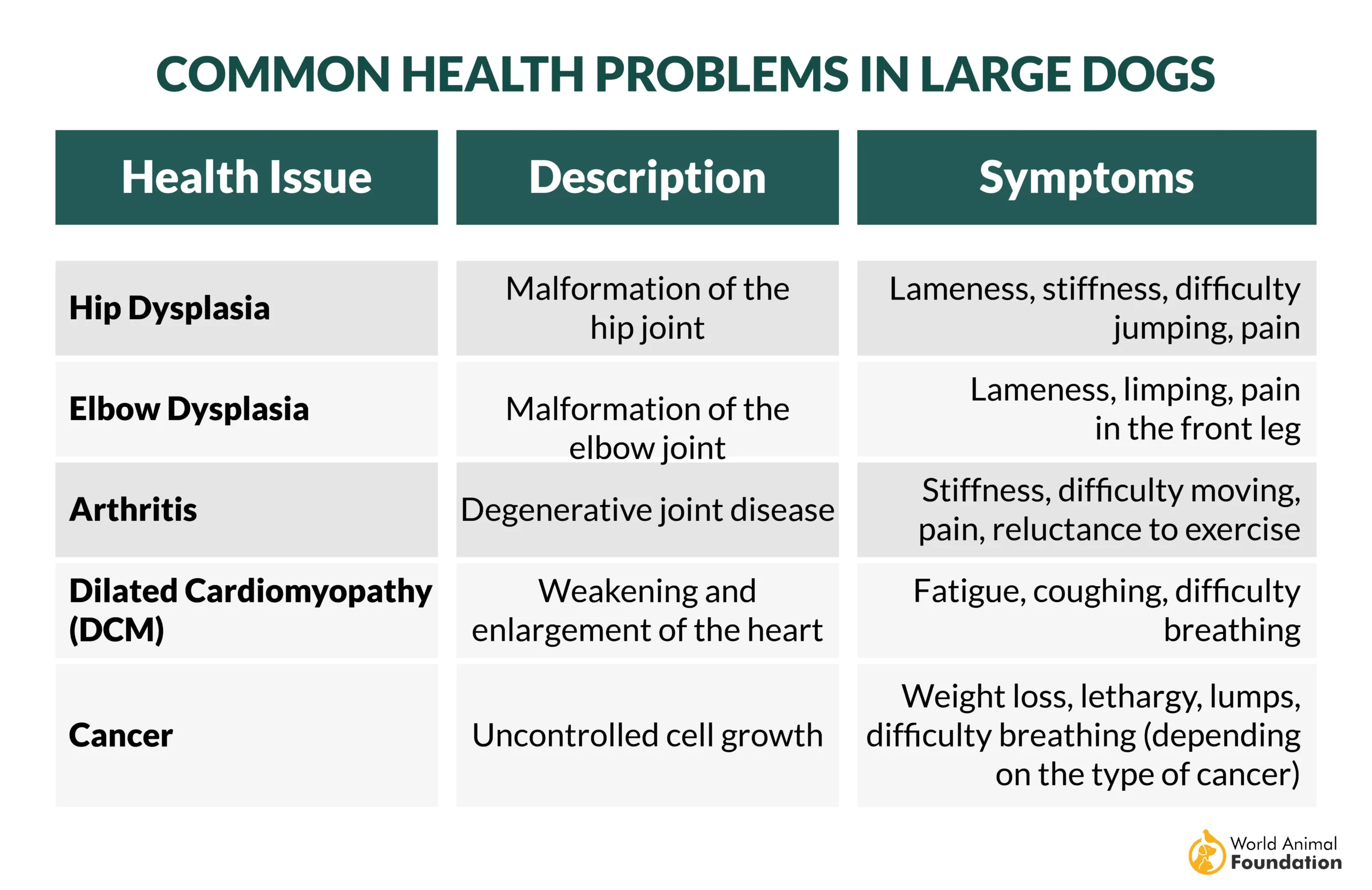
Their loose, wrinkled skin and short coat require regular maintenance to avoid irritation. Weekly brushing and daily wrinkle cleaning prevent infections. They’re prone to drooling, so keeping towels handy helps maintain cleanliness.
Although their lives are short, Neapolitan Mastiffs offer years of steadfast devotion and protection. Their calm strength and deep loyalty make them unforgettable members of any family.
Quick Tips
Clean facial folds daily to prevent irritation.
Avoid overexertion—gentle walks are best.
Feed a balanced diet and monitor heart health.
5. Newfoundland
The Newfoundland is a powerful yet gentle breed, famous for its water-rescue instincts and kind, loyal nature. These gentle giants are affectionate, dependable, and great with children, but their lifespan is shorter than most, typically around 8 to 10 years. Despite their size, they are calm, loving companions who thrive on human connection.
Newfoundlands have thick, double-layered coats that protect them in cold water. Regular grooming is essential to keep their fur free of mats and debris. Weekly brushing and consistent coat maintenance also help manage their heavy shedding throughout the year.
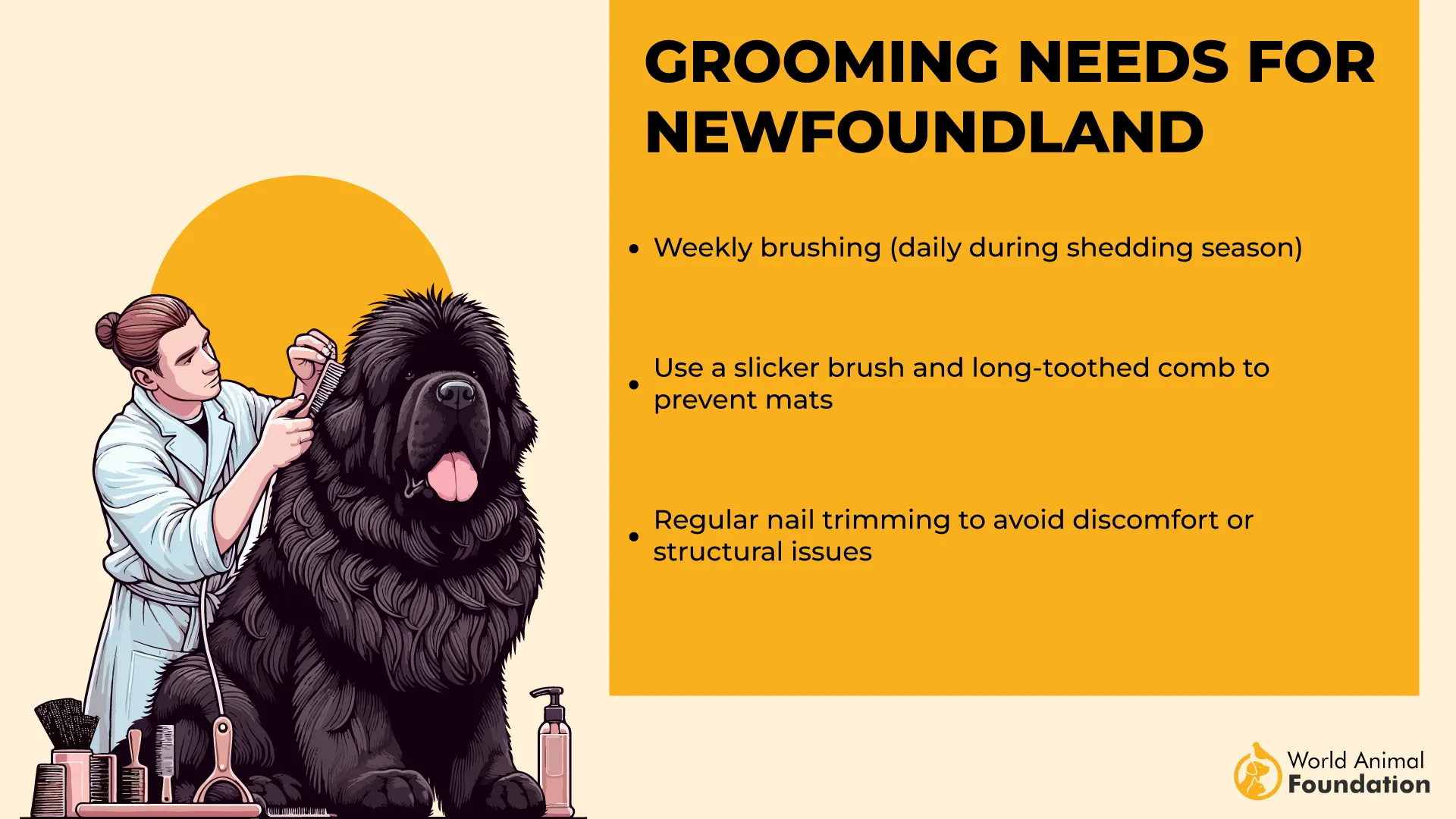
According to Hill’s Pet, their large frame puts strain on the heart and joints, making exercise balance crucial. Short walks and swimming are ideal activities that keep them healthy without overexertion. A nutritious, portion-controlled diet supports their energy while helping prevent obesity.
Common health issues include hip dysplasia, heart conditions, and gastric torsion. Routine vet visits and careful monitoring of diet and weight can extend their lifespan. Keeping them cool in warm weather is also important since they’re sensitive to heat.
While their years may be few, Newfoundlands fill each one with devotion and quiet strength. Their loyalty, gentleness, and instinct to protect make them unforgettable family dogs.
Quick Tips
Brush and detangle their coat several times a week.
Provide light daily exercise, preferably swimming.
Monitor diet closely to avoid weight-related issues.
6. Saint Bernard
The Saint Bernard is one of the most iconic large mountain dog breeds, known for its rescue work in the snowy Alps. These massive yet affectionate dogs are famous for their patience, loyalty, and protective instincts. Sadly, their average lifespan ranges between 8 and 10 years, primarily due to their large size and predisposition to health issues.
Saint Bernards are gentle giants at heart, making them loving companions for families with children. Their calm demeanor and nurturing nature make them wonderful pets for those with space and time to care for them properly. They thrive in cooler climates and need shade and hydration in warmer months.
Saint Bernards can suffer from joint issues, heart disease, and gastric torsion, common among large breeds. Regular vet care, joint supplements, and a balanced diet help reduce these risks. Proper feeding routines, like multiple smaller meals, also support digestion.
Because of their dense coats, weekly brushing and occasional baths help manage shedding. Owners should clean their ears regularly and check skin folds to prevent irritation or infection. Their drooling is normal and part of their charm, though keeping towels nearby is wise.
Though they live shorter lives, Saint Bernards bring immense love and comfort. Their devotion, courage, and tenderness make every moment with them truly special.
Quick Tips
Groom weekly and clean ears to prevent infections.
Feed smaller, frequent meals to reduce bloat risk.
Keep them cool and hydrated in warm weather.
7. Bullmastiff
The Bullmastiff is a powerful yet loyal breed that blends courage with affection. Originally bred as a guard dog, it remains one of the most protective yet loving family companions. Unfortunately, its average lifespan of about 7 to 9 years is relatively short due to its size and genetic health challenges.
Despite their imposing build, Bullmastiffs are calm, affectionate, and gentle with children. They are deeply loyal and thrive on companionship, forming strong bonds with their owners. Early training and socialization are key to shaping their confident but even-tempered nature.
Health concerns such as hip and elbow dysplasia, heart disease, and certain cancers affect this breed. A balanced diet, portion control, and routine health screenings can extend their comfort and lifespan. Joint supplements and moderate exercise help prevent stiffness.
While their lives are shorter than many breeds, Bullmastiffs make an enduring impact through their steadfast loyalty and love. Their presence provides both comfort and security for every family they protect.
Quick Tips
Brush weekly and maintain clean skin folds.
Provide moderate daily walks to prevent joint strain.
Keep diet balanced and watch for early health changes.
8. Rottweiler
The Rottweiler is a powerful, loyal, and confident breed with a long history as a protector and working companion. Despite their strength and intelligence, they have a relatively short lifespan—averaging around 8 to 10 years—due to their size and susceptibility to certain health conditions. With the right care, however, they live deeply fulfilling lives full of devotion and love.
Known for their courage and dependability, Rottweilers form unbreakable bonds with their families. They are affectionate and calm at home but need proper training and socialization early on. With structure and consistency, these dogs grow into trustworthy and obedient companions.
Their short, double-layered coat requires minimal grooming—weekly brushing keeps it shiny and healthy. Regular baths and nail trims complete their simple care routine. Exercise, such as long walks or structured play, keeps them fit both physically and mentally.
Rottweilers are prone to hip and elbow dysplasia, heart disease, and certain cancers. A balanced diet, weight management, and regular vet visits can help prevent or manage these conditions. Early health screenings are especially important for large-breed dogs like the Rottweiler.
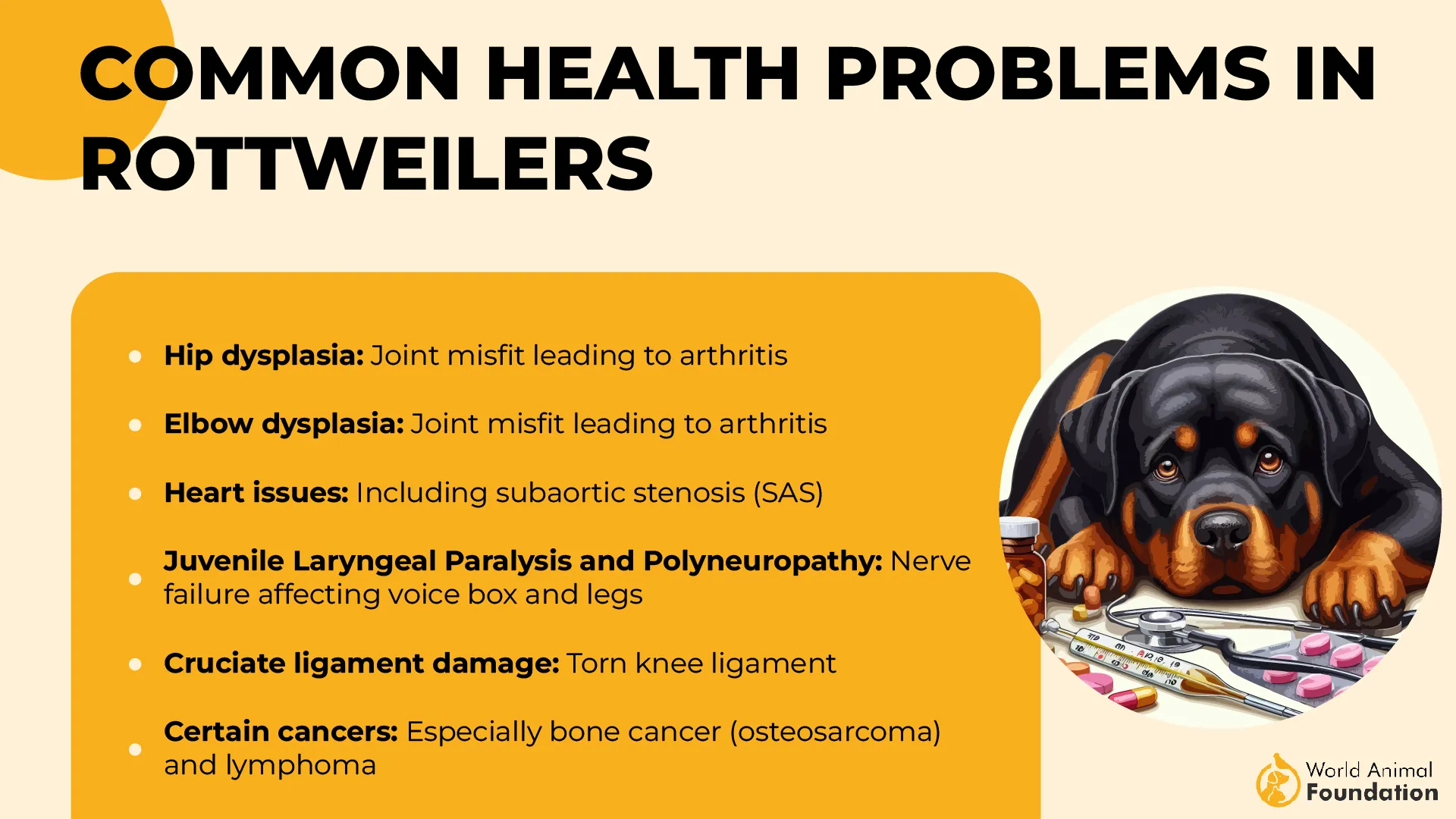
Though their lifespan may be limited, Rottweilers leave a lasting legacy of loyalty, strength, and affection. They are steadfast protectors and loving companions who enrich every household they join.
Quick Tips
Combine daily physical and mental exercise.
Feed a high-quality diet to support heart and joint health.
Begin obedience training early for best results.
9. Mastiff
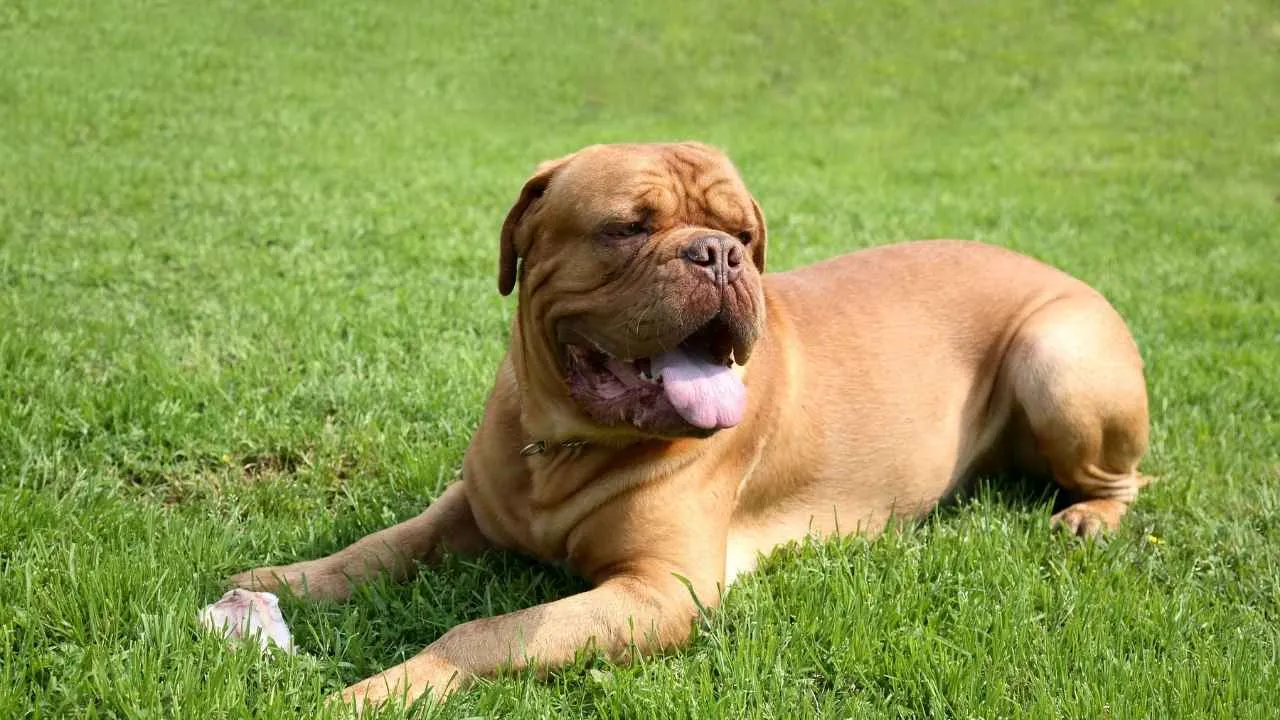
The Mastiff is one of the world’s oldest and largest dog breeds, admired for its calm temperament and unwavering loyalty. Known for their sheer size and protective instincts, Mastiffs tend to have one of the shortest lifespans—averaging just 6 to 10 years. Despite their brief time, they bring immense comfort and love to their families.
These gentle giants are affectionate and devoted, forming deep emotional connections with their owners. Though imposing in stature, Mastiffs are surprisingly gentle with children and make excellent family companions when properly trained. They thrive in homes with space to move and a calm, steady routine.
Their short coats are easy to maintain, requiring only occasional brushing and baths to keep them clean. Regular grooming helps reduce shedding and maintain healthy skin. Because of their drooling and loose jowls, daily face cleaning is also recommended.
Health problems like hip dysplasia, heart disease, and gastric torsion are common among Mastiffs. A proper diet, weight control, and controlled exercise can help prevent stress on their joints and internal organs. Regular vet checkups are essential to catch any issues early.
Though their lives are brief, Mastiffs are among the most loyal and loving of all canine companions. Their quiet dignity, courage, and affection make them unforgettable members of any family.
Quick Tips
Keep exercise low-impact and consistent.
Maintain a lean diet to reduce joint and heart strain.
Clean facial folds and jowls daily.
FAQs
1. Why do some dog breeds have shorter lifespans than others?
A breed’s life expectancy often depends on genetics, size, and specific health risks. Large or working dogs face a higher risk for heart conditions, joint problems, and gastric dilatation volvulus, while smaller dogs generally age more slowly.
2. Can I extend my dog’s life through proper care and diet?
Yes, providing the right food, maintaining a healthy weight, and treating pain or arthritis early can help. Regular vet checkups, exercise, and love from a caring pet parent all contribute to a longer, happier life.
3. Are large dog breeds always shorter-lived than smaller ones?
Generally, massive-sized dogs age faster due to the strain on their organs and bones. While genetics is a contributing factor, early prevention and consistent care can help many breeds live healthier lives despite their high risk.
Conclusion
Every dog’s life expectancy depends on genetics, care, and environment. Larger dogs, like Mastiffs and Rottweilers, often face various forms of heart disease, arthritis, and dilated cardiomyopathy, while smaller breeds like the Chihuahua or Pug tend to live longer. Regular vet visits, proper food, exercise, and early treatment for pain or joint problems can add precious years to your canine companion’s life.
Responsible pet parents can make a big difference by recognizing health changes early and offering quality care. Other dog breeds, such as the Bulldog, Dogue de Bordeaux, and other dogs with similar risks, remind us that every age counts—so spend each day giving your loyal friend the best life possible.


